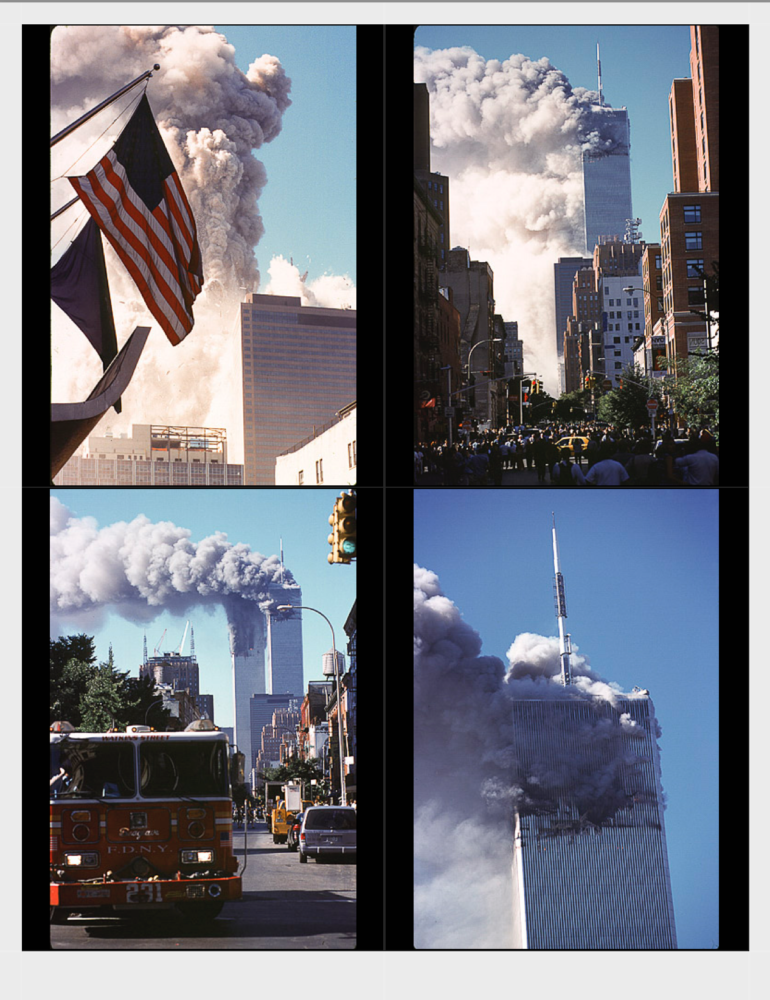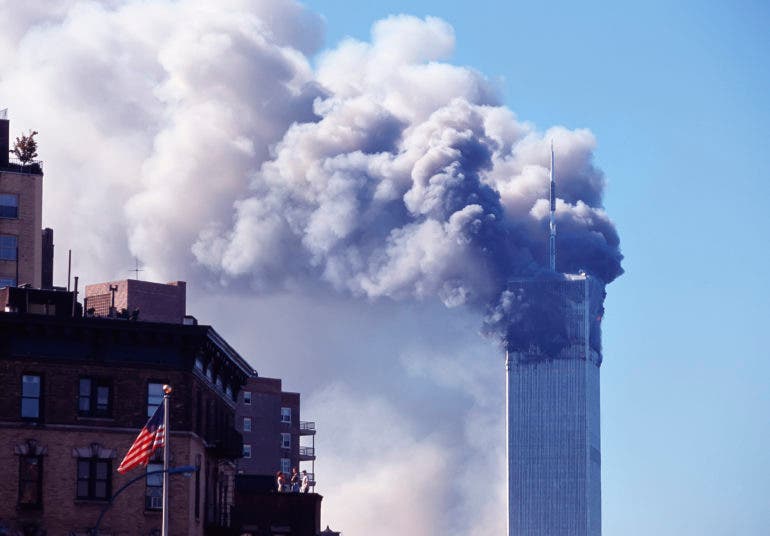These Photographers Share Important Stories Around 9/11
We’re streaming daily on Apple Podcasts, Google Podcasts, Stitcher, Pocket Casts, and Spotify! You can also listen to it right here on The Phoblographer.
Twenty years later, my biggest fear is that major stores and corporations will turn 9/11 into a giant holiday. People will use it as an excuse to get out of work. They’ll turn it into three-day weekends. They’ll BBQ. They’ll drink. It’ll become associated with debauchery. We Americans already do it with Memorial Day. Truly, how many people actually take the time to remember the fallen soldiers? The sad likelihood that consumerism may overtake what should be a national day of mourning is heartbreaking. And looking at photos of the events doesn’t really get any easier.
Over the past years, I’ve made it a point to not publish anything unrelated or anything at all on 9/11. People typically come to The Phoblographer as an escape from big news stories and the “important” things. In our ways, we work to do our own good in the world by putting a smile on our readers’ faces. And at times, we bring major issues to light. And that’s what I want to do today.
Today, we’re featuring the stories of photographers who shot what happened on 9/11. Some of you reading this were not even born. Some of us will forever have it etched in our minds. I’ve paused frequently while writing this and had conversations about 9/11 and what I saw. At 14, I saw the second tower get hit from my religion class in St. Francis Prep. It was nuts. A few of us went to the window to see it while our religion teacher just tried to redirect our attention to what was happening in class. That day, my dad had to walk from the United Nations in Manhattan across the bridge to Astoria and then find his way down to a few blocks away from JFK airport. The entire city shut down that day. And for the next week, our school was shut down.
The news outlets, this one included, are going to keep doing what they do. We’re going to keep creating stories about this date because it’s incredibly important. September 11th, 2001 shaped a major portion of world history. New photographs and information about it are still being discovered. New stories are often coming out.
I know that everyone sometimes gets sick of the news and all the awful things happening. But this day, specifically this one day, is one we should internalize, reflect on, and understand. And there are tons of other stories. Photojournalists do what they do for a reason. Some of you may not want to talk about the politics of it and just like to focus on the photos themselves. But the truth is that the world isn’t a theater for our own entertainment. Real people are involved every single day and many of us are privileged enough to be far removed from the chaos.
It’s easy to think, “Well, it doesn’t affect me.” But selfish and I’d hope that the strides made in the past two years won’t diminish. Freedom is only truly free when no one is inconvenienced, but these photos show that many people were indeed inconvenienced, to say the least. And the actions affected wonderful, loving folks all over the world, just like you.
Sometimes, it makes sense to personalize these stories, so how about I go ahead and do that. Throughout today, we’ll be publishing a variety of stories regarding 9/11. But we’re also rounding up some very critical ones right here for you.
“I think a lot of people thought I took photos when I shouldn’t be, but I never felt that way. And it’s important to say, my dad never asked that I stop shooting either. And he always asked his doctors if it was ok if I come to appointments before I arrived. But, I will say, in the last month I saw him, I took photos because it was the safest way to keep the tears hidden when I was around him. ”
Jennifer Judkins
Jennifer Judkins used a camera to hide her own pain as she saw her father, part of the cleanup crew, slowly decline. She even shared his contact sheets with us.

“We were all in shock, you could read it on the faces of all those around me living through this singular moment, but as many photographers have come to learn through experience, when you are behind a lens you are detached in a way that allows you to keep shooting when you might otherwise be overwhelmed with emotion.”
Michel Leroy
Photographer Michel Leroy doesn’t do photojournalism anymore. But his account is one of the most truly eye-opening we’ve read.

This photographer walks in, drops off his pictures and stands off to the side. I asked him “Are you okay?” He says he was standing there with the camera in hand and all of a sudden him and the firemen hear these sounds. THUNK! THUNK! He didn’t know what it was. When he turned around, he found out it was people hitting the ground and jumping out of the World Trade Center. He says to me “I couldn’t lift my camera.” He was covered in ash, and tears were coming down his eyes. They were flesh colored where the tears were streaming down and cutting through the ashes. That photographer cleaned himself up in the bathroom and he went back out there.
Ron Herard
Ron Herard worked at a film lab when 9/11 was happening. Seeing and hearing the reactions from tons of photographers is something he experienced personally.

“The man had run into the store screaming, he could not believe he had made it. After waiting a few minutes, I asked if he minded if I took a couple of pictures.
Once we could see out of the front window of the store, I went outside. It was then that I started to see people walking towards me in their weakest and most vulnerable of moments.
You ask yourself, can I do this?
The scale of the event was so big. I just started to take pictures and would ask people if they were okay.”
Phil Penman
Phil Penman shares a story about how he grabbed his camera and headed out on 9/11–and all that happened.
I think that, you know, when you’re using a camera, the camera is a little bit of a shield between you and what’s going on there. Had being behind the camera affected your emotions in any way? Yeah, I think it, as previously mentioned, allowed me to just focus on the capture and a little bit less about the reality. I mean I’m always respectful to my subjects, but the fact was that people really did not see me when I was there. It was such a powerful experience for so many, and everybody had cameras that people were not really paying attention to me. And I think, you know, did I channel my emotions into the images? Yes, I mean, I think I was in all those pictures. I think a lot of the emotions that I was able to capture at the scene I definitely felt, and I think, you know, as a body of work, in a way it was cathartic and therapy for me to deal with kind of what had happened. And the reality is that you know, the camera always reflects both what you’re looking toward and you as the artist looking at it, and I think that photography has always been a form of therapy for me. But in this particular charged situation, it was really a welcomed distraction from the reality and it gave me a mission that I thought, you know, I could capture something without looking at the actual scene itself, but capture an atmosphere and a feeling behind this event that will always be a big part of our history and world history.
Steve Simons
Photographer Steve Simons told us about how he did his job as a photojournalist on 9/11.

“One of the most moving stories, when I was photographing survivors, was this firefighter. He was with a group of other firefighters heading down the stairs to get out of the building’. He and another buddy found some woman that was panicking. So they got her, and he sent the rest of his guys down before him so they could take this woman. The building collapsed while he was in it. But he was on the floor where all the air conditioning and mechanical stuff were. That floor was really reinforced because of all the mechanical stuff. He survived, but all his guys below him didn’t. He could hear them screaming. The force of the building collapsing and the air blew his helmet off of his head. Three or four months later they found it. He brought the helmet in for Ira to photograph.”
Ira Block
Ira Block is a National Geographic photographer and did a special project on what happened after 9/11.
I hope that the stories we bring you today and have brought you before will really grip you. And whatever you do, please check in on your friends.
All images used with permission from the photographers in our interviews.